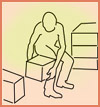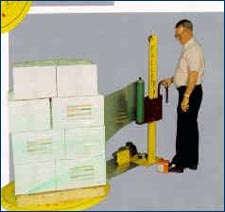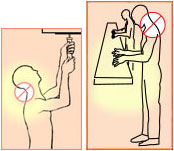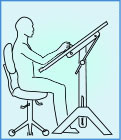Solutions for Electrical Contractors eTool
Ergonomic Solutions » Shoulders, Upper Back, and Neck

The following describes common ergonomic risk factors (such as reaching and tilting the head back) that may increase the chance of injury and pain to the shoulder, neck, and upper back. General solutions that may minimize the possibility of injury and pain are also presented.
Potential Hazards


-
When the torso is bent forward or to the side, the weight of the upper body must be supported as well as any other objects held in the hands. Employees who must work for prolonged periods of time in a bent-at-the-waist posture put significant strain on the back even if they are not lifting significant weight.
-
Twisting and bending pulls the back out of its normal alignment. This can pinch and alter the discs, making them more susceptible to bulging and rupture. This also forces the muscles of the back to work singularly instead of in tandem, making them more susceptible to overexertion and strain.
-
Finally, maintaining static postures for prolonged periods slows nutritional flow and removal of wastes to the muscles and tendons. This can create fatigue making them more susceptible to injury.
Possible Solutions




-
Keep the load directly in front of the body. Avoid reaching to the side or twisting when lifting.
-
Keep the load close to the body when lifting.
-
Use automation whenever possible to reduce repetition and duration of lifting tasks performed in awkward postures.
-
Reposition loads so most lifts can be performed at about waist height with the elbows in close to the body.
-
Use positioning devices, such as scissor lifts, lifter/tilters and palletizers, to raise and position loads so they can be lifted while close to the body with the back in a straight alignment.
-
Use devices with rotating platforms so loads can be easily positioned close to the body before lifting.
-
Use elevating and tilting bins, which elevates the load and keeps it close to the body.

Potential Hazard


-
Repeatedly tilting the head forward, backward, or to the side, or holding it in these positions for prolonged periods can fatigue the shoulder and upper back muscles. Examples are, tilting the head forward to perform assembly line work, tilting the head backward to perform overhead work, or looking to the side to use a poorly placed computer monitor. These postures can also pinch the nerves as they radiate out from the spine and must pass through clenched muscle groups.
Possible Solutions


-
Use height-adjustable work platforms so employees can be raised or lowered to minimize forward or backward head tilting.
-
Use height-adjustable work surfaces or lift tables to minimize tilting of the head and bending of the neck. For example, computer monitors should not be above eye level.
-
Tilt work surfaces toward employee such as drafting tables so the head can be held straight.
-
Minimize prolonged overhead activity by rotating employee tasks that require prolonged awkward head postures or by providing rest periods.

